Kathy Butterly (NA 2017) is one of today’s most intriguing visual artists. She is a master of form, expression, and color, conjuring many-layered meanings throughout her incredibly diverse range of work.
I first met Butterly in the late 90s at the University of California, Davis, where I was her mentor and advisor, and we have remained in touch since. I continue to be inspired by her work.
In 2007, I was thrilled that the jurors for the inaugural Artists’ Legacy Foundation Artist Award—Michael Henderson, Judith Shea (NA 1995), and John Yau—selected Butterly as the first recipient. The choice of Butterly was particularly special because the award was only possible through a generous bequest from Viola Frey. (Frey, along with Gary Knecht and myself, was a founder of the Artists’ Legacy Foundation.) As you will read in our conversation below, Frey was an instrumental element in Butterly’s artistic development.
Fast forward to this past fall, when I was elected as a National Academician. I was honored to join Butterly among the thousands of American artists and architects who have been a part of this community since 1825. Butterly and I connected during this time around the opening for her first retrospective, Kathy Butterly | ColorForm, which was presented at the Manetti Shrem Museum of Art and curated by Dan Nadel. We discussed everything from painting to process to popular culture.
Squeak Carnwath: How did you get started? Did you always want to be an artist?
Kathy Butterly: I didn’t come from a family that really understood art. Still, I think I was an artist from the beginning. When I was in kindergarten, my teacher told my mom, “You should get your daughter art lessons. She’s got talent.” And my mom listened. I started with charcoal classes and continued with oil painting. When I entered high school, I was known as one of the “art kids,” and I loved it.
In my town, everyone went to college and then got a “real job”—one where you work from nine to five and have a steady paycheck. At first, I didn’t know that being an artist was an option. At the same time, I knew I wanted a creative life, so I took some drafting and architecture classes. There was far more math than I wanted, so I switched to interior design. And that’s when I started looking at art schools. I visited Moore College of Art & Design in Philadelphia, and it just felt right.
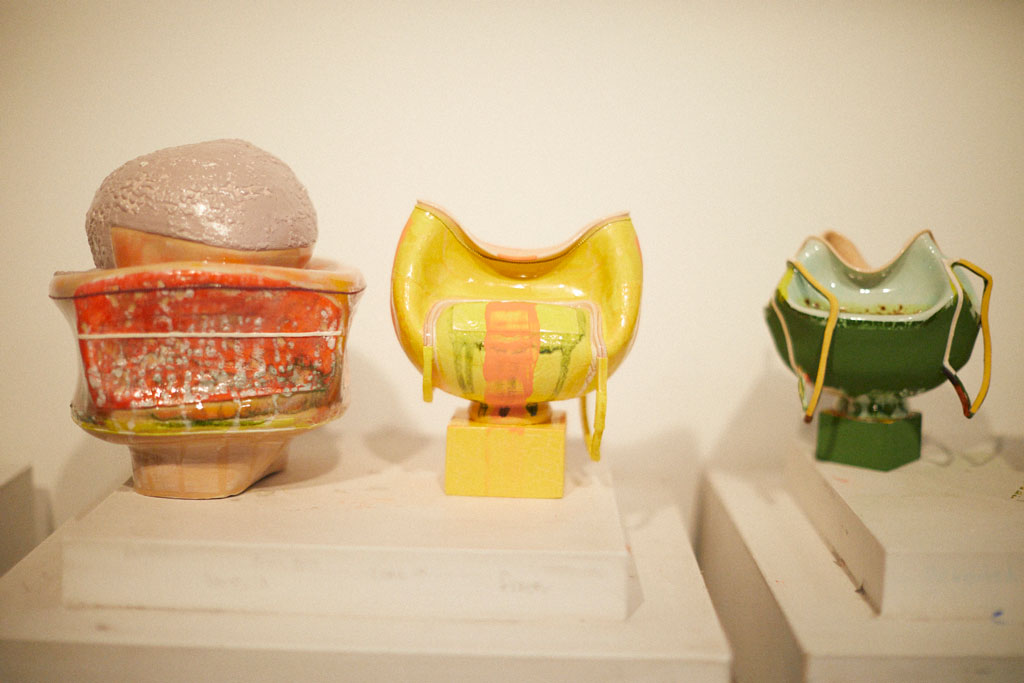
How did you go from interior design to ceramics?
Shortly after I arrived at Moore, I peered into the studios on campus and saw people painting and sculpting. I was like, “Wait! You can do that? You’re allowed to be an artist?” Right then and there, I decided I was going into painting.
I did all the core courses, but something just didn’t feel right. I was bored. I didn’t feel that pull; that need; that desire. I tried welding, which was so not me. I felt removed from my art because I couldn’t touch anything. Next, I went into jewelry, which wasn’t me either. But during that time, I also took an introduction to ceramics course because I wanted to make a container to hold my paintbrushes. At that time, I thought ceramics was strictly about creating utilitarian objects.
The following year, Viola Frey came to Moore. I saw her solo show, It’s All Part of the Clay, at the college gallery, and attended a demo on how she formed the base for one of her monumental sculptures. When I met her and saw her work, a lightbulb went off over my head. Suddenly, I knew what I had to do: combine painting and sculpture.
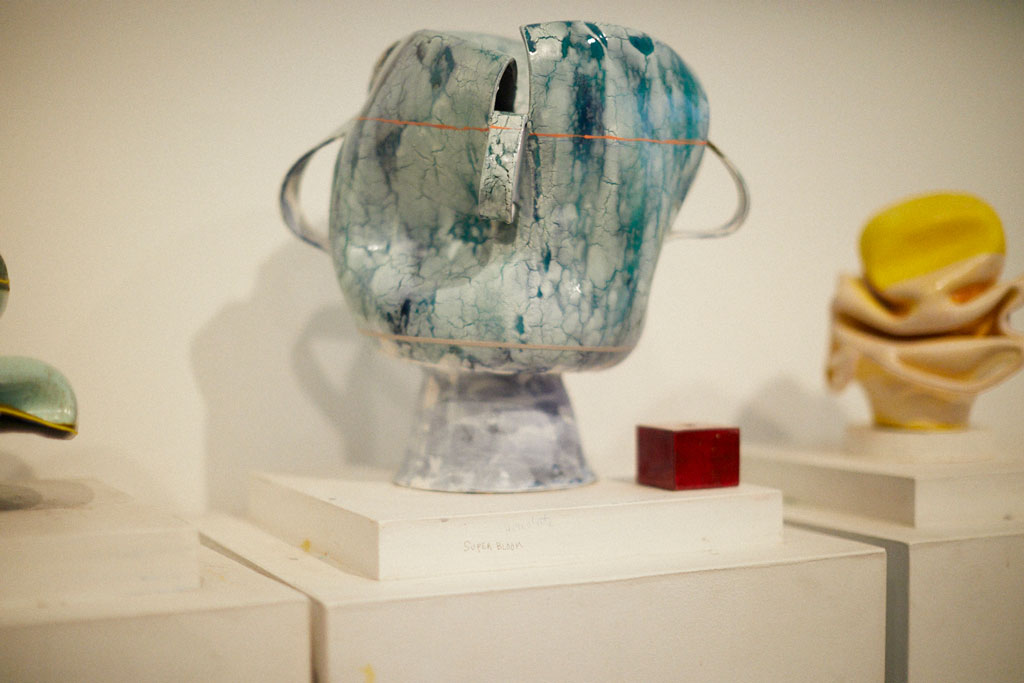
You realized that ceramics don’t have to be purely functional.
Exactly. Viola’s sculptures were extremely political. They spoke to me. When I was at Moore, it was an all-women’s school, but most of the faculty were men—and so was the president. Having Viola arrive and be such a force—she blew my mind. She was confident, smart, and inspiring. I finally had a role model.
You say you found painting boring, but I consider your use of color painterly.
Painting felt boring to me at that time because we were doing still lifes. Building your skillset as an artist is crucial, but I also needed to connect with my feelings. I didn’t know how to do that while being told, “Here’s what you’re doing. All the answers are in front of you.”
Painting is a philosophical object; a thing which is not what it is. It’s not what is represented on the canvas. It’s this other thing that exists on its own. It is real, but isn’t real. It can’t be real because it is a thin coat of stuff on a flat surface. Its reality exists in our minds.
You nailed it. That’s what I love about painting. When I go to a museum, I head straight to the paintings. They’re my true love. With a painting, your mind goes into each piece, whereas with sculpture or ceramics, it’s about the body. You see a physical object that inhabits the real world. I’m interested in the intersection of mind and body—in making something “real” while also taking your mind on a journey.
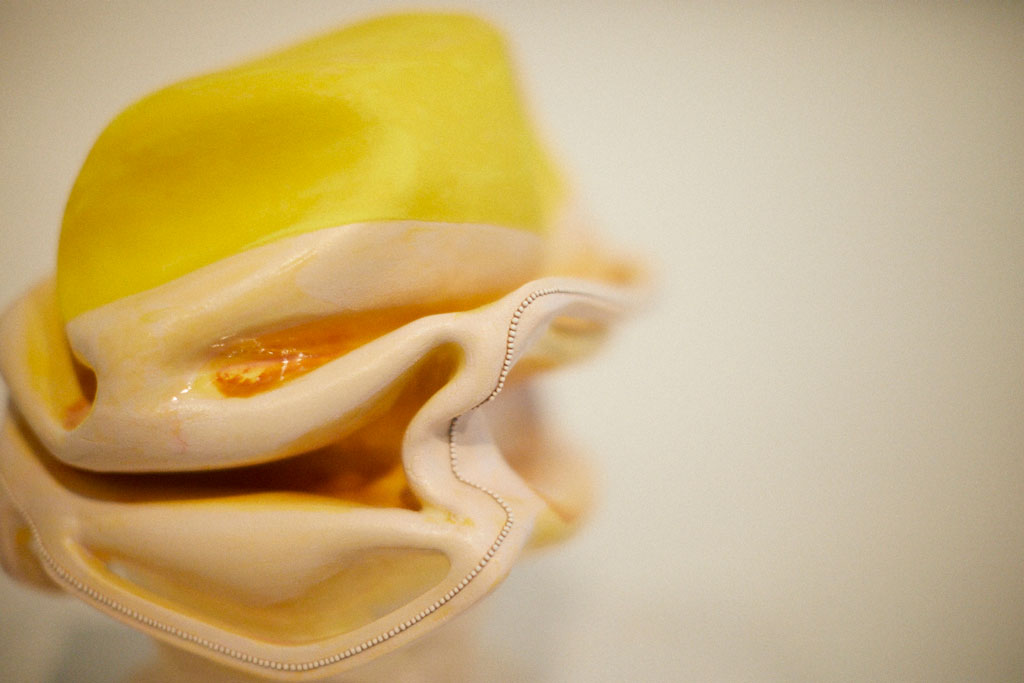
Your combination of painting and the physical object is transformational. Each of your works has a distinct personality or persona. How does this happen? Do they emerge before, during, or after you create each piece? Or, is it based on intuition?
It’s totally intuitive. They tell me what they want, and I try to make it happen.
I work the same way.
What’s your least favorite question you get asked?
“Can you tell me how you did that so I can do it, too?”
That’s a terrible question.
I try to make each piece feel effortless—like it simply exists. In reality, it’s quite time-consuming and not effortless at all. It’s a struggle. But that’s a big part of what I love about my process. It’s not a recipe book, and I don’t know what the end result will be. It’s a journey, and when I complete a piece and it feels right… that’s the best feeling. No one can tell you how to achieve that.
When students used to ask me how I did certain things in my paintings, I’d answer that I looked at other paintings, went back to the studio, and tried it myself. Even though I like to think I figure out how other artists work, I never do. Instead, I discover my own way. Everyone should look carefully at other work, and then find their own way.
With ceramics, there’s a storied tradition of passing on techniques and recipes. It’s great, but can also be limiting. Trying to redo or copy another artist’s work can be a good learning tool, but figuring it out for yourself makes it your own.
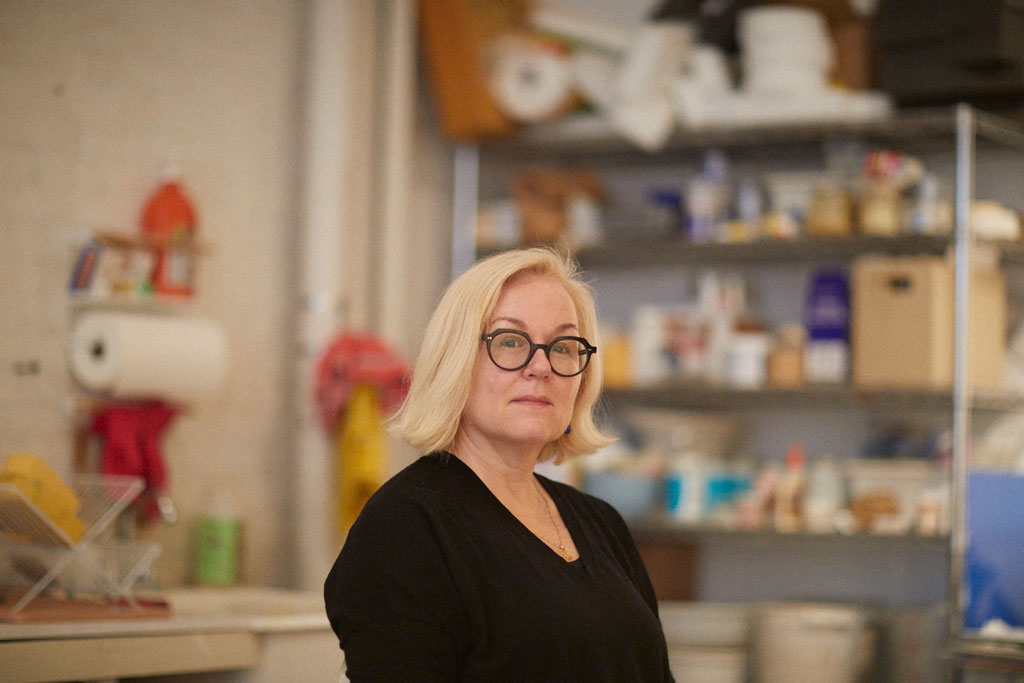
The way you use color is sumptuous and thoughtful. What informs your use and understanding of color?
I love color, and I think about it all the time. I don’t follow any color theory because I believe color is felt and intuitive. I’m moved by nature—for example, how color works on a flower. In fall, I like to visit Tompkins Square Park in New York to walk under the elm trees. They turn brilliant yellow, and I feel alive and happy.
When I glaze, I build up colors. I put on a color, fire it, and respond by adding additional color and texture that feels right in that moment. I continue to layer and look for a push and pull; that seduction and repulsion which is achieved through color.
How has your life and family influenced your work?
Oh, so much. I went into labor with my son in the very studio where I’m sitting right now. My family is everywhere. They’re an integral part of my life, my time, and my thinking.
When I was pregnant and had little kids, my world was very small. My works were small, too, because my personal life was full and intimate. I found power in that. Looking back, when I was pregnant, my works were about the belly. After 9/11, I looked at what had happened to this city I love, and I started making my series Heavy Heads. All my works had enlarged heads. It was how I dealt with my fear.
Now, the scale of my work is getting larger. I have command of my materials, and I’m looking for challenges. More and more, I’m considering the world at large—the environment and politics. But I also want to keep the powerful intimacy of smaller works.
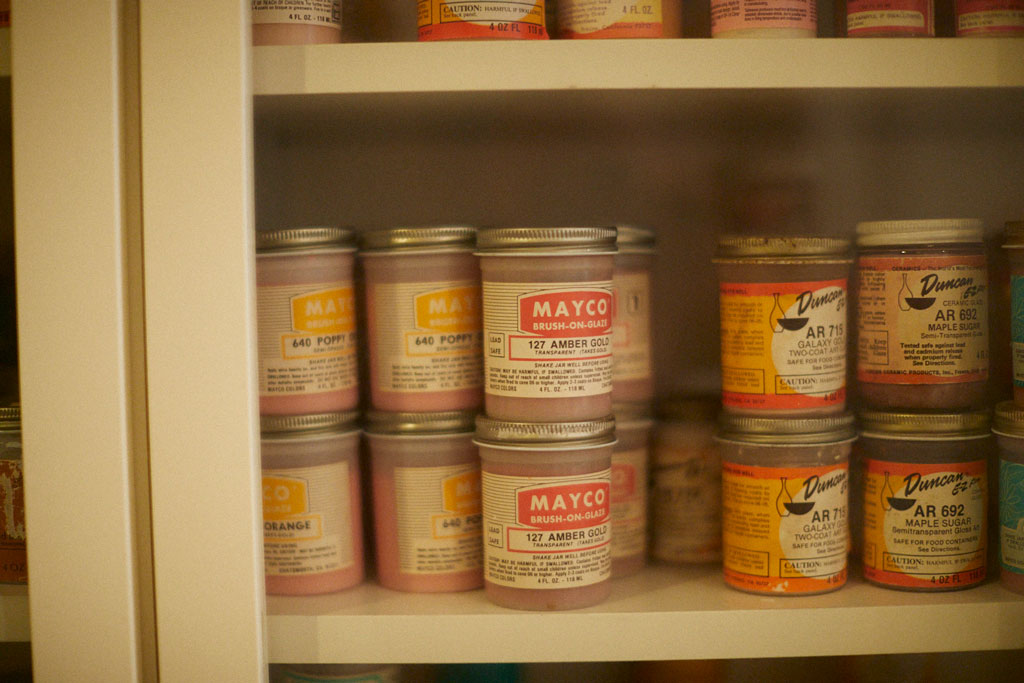
Is there a “Butterly Theory” of size or scale?
You know, I think there is. My theory of scale changes because I change. When I got into UC Davis for graduate school, my heart had been broken by a personal tragedy. I was making pieces that were about five-to-six feet tall with imagery carved onto their outsides. At the same time, I started creating small, personal pieces. I felt the larger pieces were illustrating ideas, whereas the smaller works were the actual “meat.” They were the heart of what I needed to express. Small, intimate works have this power to pull you in and keep you there. Many of the world’s greatest masterpieces are on a smaller scale—works by Van Gogh, Alice Neel, even Piet Mondrian’s Broadway Boogie Woogie.
Right now, my theory of size is to create what I enjoy, but continue to make a statement that small can be powerful. Working small is about going to a deep place and finding something that feels large.
My theory of size is that with a small work—anything smaller than the size of your head—you can telescope yourself into a miniature world and wander around in it. With a middle size—the size of a window, or the space between your head and crotch—we censor that. We repress it because it has a different feeling, as if the artist might be holding back. With a large piece—bigger than a human body—the work encompasses you. You can fall into it.
The medium size has never made me feel comfortable, but I’m drawn to it. In the past, I have made works that are either small or large because both are extremely demanding, technically and conceptually. With small works, I want to pull you into my world and hold you there—just like you described. With large works, it is physical, like standing beside a body. I’m a little lost when it comes to a medium size, but that’s where some of my work is going, so we’ll see.
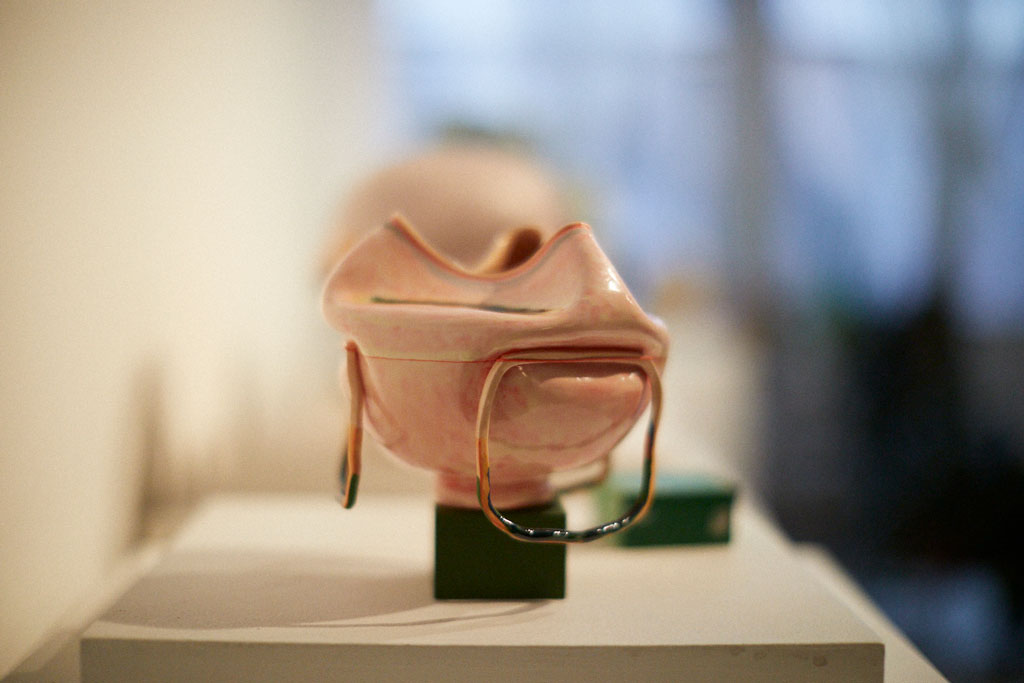
What do you do when you’re stuck?
I haven’t been stuck in a while—knock on wood! There’s just so much happening in the world that I want to process through my art. I continue to be interested in color, size, and how glazes work, so it’s hard to get bored. When I do get stuck, I often go to museums and look at the masterpieces. Then, I work through it. Maybe I’ll screw up something on purpose to see where it takes me. Maybe I’ll start a new piece. It’s certainly not easy.
I agree. Would you say that labor is an important aspect of your work?
Absolutely! There’s a lot of joy in making work—and then there’s a lot of labor. I like both. I like having a laborious task.
A few days ago, I cast the initial form for a piece, and then today, I altered that form. At a certain point, I connected with it and added large, clunky lines, and then started to refine it. Once I begin to refine a piece, it becomes alive. It’s the most sensual process. I get lost in it.
The time I spend crafting is essential. I will spend three weeks hand-carving a little pearl necklace, and then take days to glaze it. While it may be the most ass-backwards way of working, it’s necessary. Everything is fast-paced nowadays, so time is the most luxurious thing in the world. Going slow is a statement. My process is a reaction against the culture of mass production. Each is hand-carved and must be perfect. I want my work to feel like it has every right to exist, and the only way to achieve that is through labor and time.
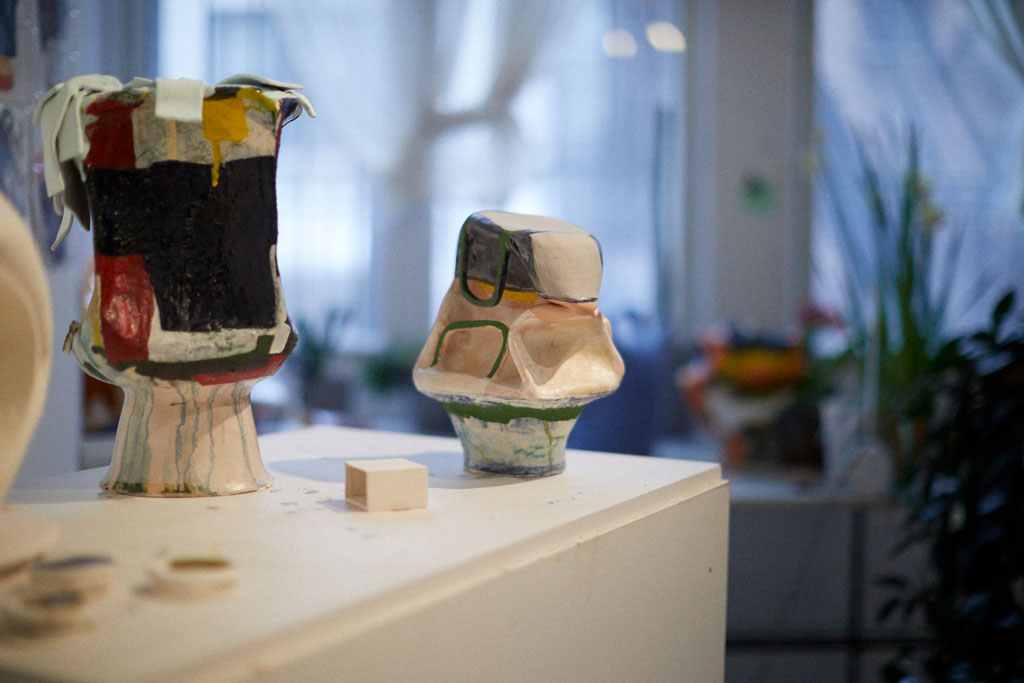
To have the work know it belongs in the world.
And to have no doubt about it. I don’t put a lot of work out there, and I don’t want to. I want each piece to know it is important and has a place. It takes up and commands space. I feel that small forms actually need a great deal of space around them in order to be fully seen.
One interesting aspect of clay is that it automatically captures touch in the act of creation. It turns touch into feeling with minimal technical help. I think people love working with clay because they want a record of their ability to touch and feel.
People need something real. We live in this tech-heavy world where many people work in isolation on computers. Some don’t even talk to each other anymore. We’re missing human connection. We’re missing a connection with nature. We need to touch things and to be expressive. Clay gives that to people.
I agree. Everything is glassy-smooth right now, and people either want shiny objects made of resin or glass, or something so overtly physical that it could never be replicated on a screen. Working in a material like clay shows a human touch. It proves that the creator worked with an actual physical object. It is proof of life.
Maybe the lack of art education in schools is killing our world as we know it. When people take a ceramics class, it’s often something they never did before. They get the chance to be vulnerable.
When I was teaching at Princeton University, I had a student who was absolutely brilliant; he was studying to be a neuroscientist. He told me my course was the hardest one he had ever taken! This was the first time he had to express his feelings and ideas—it was abstract for him. As artists, our job is to make something that has never existed before. That’s hard!
There’s probably a whole generation that has that experience.
That’s another part of clay’s popularity. Squishing a piece of clay, firing it, and seeing it come out of the kiln—that’s extremely satisfying.
To me, the kiln is like a toaster oven that melts cheese. There’s no great mystery to it. It’s chemistry and physics, intuition and experience, and something understood and learned. You don’t have to live in fear of the right or wrong way to do it.
Does popular culture figure into your work?
Everything does. Living in New York, so much is available to me. I love looking at graffiti and the way posters peel up when they’re layered on top of each other. I like the way paper deteriorates, one shiny layer next to another dull layer. I like looking at the years of paint chipping away on subway I-beams. This is not popular culture exactly, but it’s my environment. I am influenced by the visual, auditory, and olfactory facets of being in this city. There’s so much to absorb, and it all gets into the work. Politics is big in my work right now. It may not be overt, but it’s my way of dealing with everything happening now.
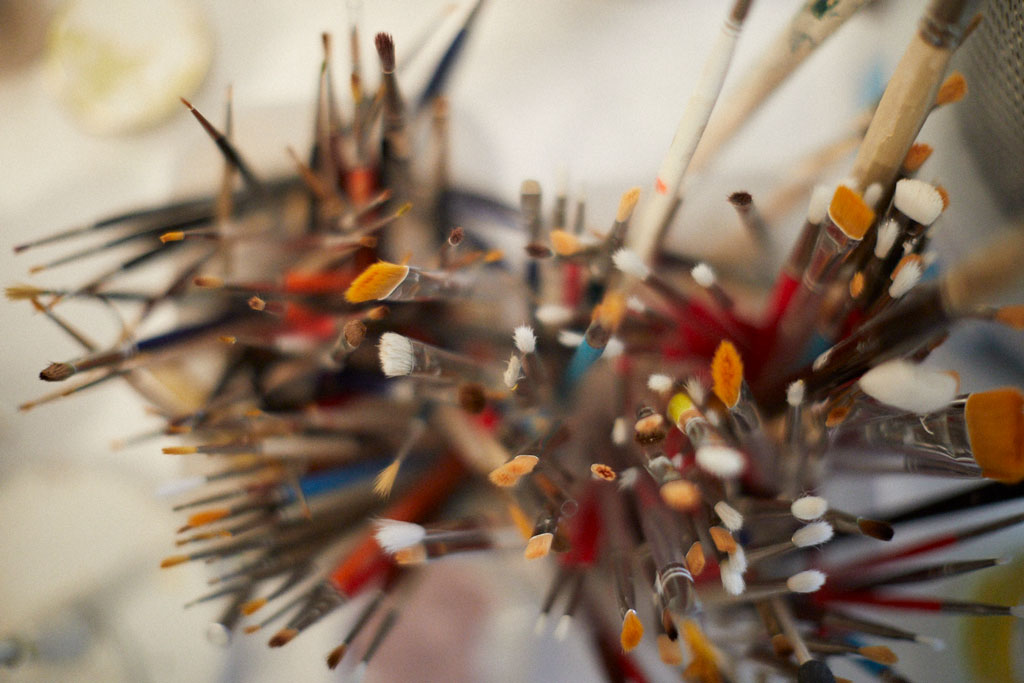
Did you watch the The Handmaid’s Tale?
I’m addicted. I binge-watched it. But it’s also time for it to end, I’d say.
After reading Margaret Atwood’s original text, I made a piece called Handmaid. I consider that a bit more political.
I know many artists were profoundly affected by the 2016 presidential election. Have you addressed these feelings in your work? Is it a form of resistance for you?
One work I created recently is titled Crossed Arms. I made it while listening to the Kavanaugh hearings. I cried as I heard Christine Blasey Ford—I think every woman I know was crying. The form of Crossed Arms was difficult because I really felt it. It has a round form that’s been a little squared off, and there are multiple handles that poke into it and create a barrier around it. The arms protect it, but at the same time, they say, “Enough is enough.”
In terms of 2016 specifically, I made a piece titled November 9th. Originally, I had glazed it with bright colors and many layers. It was optimistic. Then, on November 9th, I covered most of it in black because that was how I felt. I did leave a white strand of pearls and pink lines on the handles. That made me feel defiant and strong.
If I get stuck on a work and I like the way it is, but don’t know what the piece needs, I will work on something else. The piece I abandoned will get solved by something I learned by working on something unrelated. The two works inform each other. Then I get like a dog on a bone and have to finish the first piece.
That’s how I approach all my work. In 2018, I worked on 24 pieces at one time for James Cohan Gallery. I’ve never worked on so many simultaneously. Each one was at a different stage, had different needs, and was speaking a different story. I tend to get involved, maybe even obsessed, with just one or two pieces. But after working on them for days on end, I’ll jolt awake and see all the others. Then, I obsess over those pieces until I eventually return to the earlier ones… back and forth and back and forth. There’s no rule or reasoning, but they inform one another. I make connections between the pieces and can’t plan where they go.
Right now, I have a few pieces I have been working on for a long time that are only halfway done. Because I’m feeling lost, I’m kind of abandoning them. My plan is to start new ones and revisit these with refreshed eyes. When I pick them up again, I hope to bring something new. I think it’s the same with many artists.
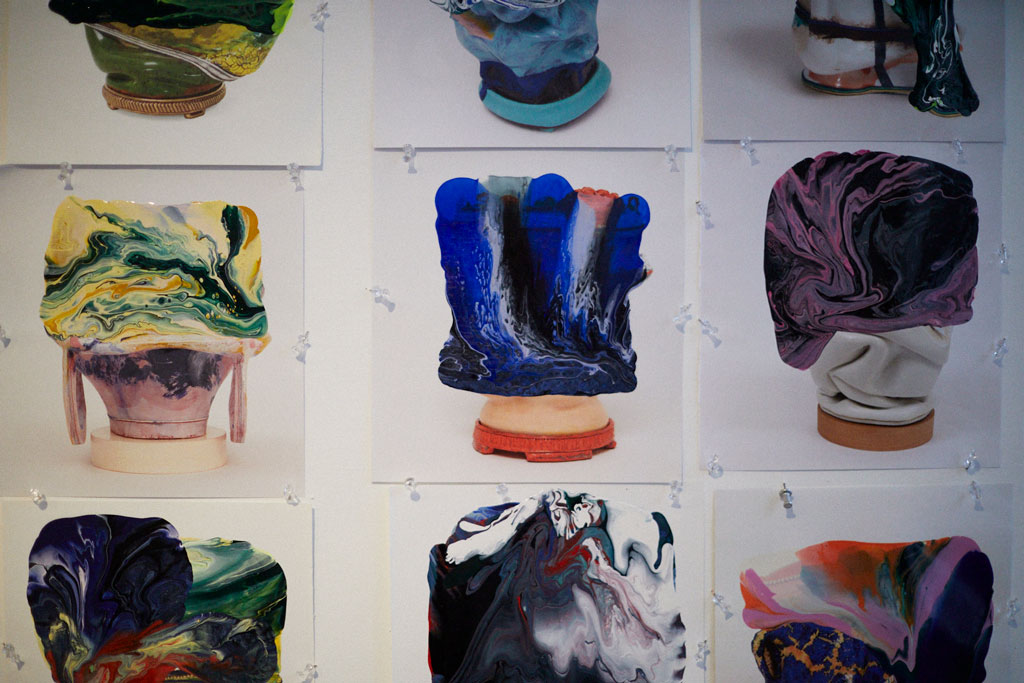
It is for me. If I get stuck, I work on something else. I find that whatever problem I had will be solved by something I learned while addressing a seemingly unrelated piece. They inform and inspire each other. Do you decorate your studio with ephemera that touch your work and inspire your aesthetic?
I have a whole wall of jars of glazes. It’s beautiful. When people visit, they say, “Oh, your studio is so pretty.” It needs to be. I’m here all the time and I want to love where I work. When I pour out a glaze, I use a lovely porcelain dish because I want to enjoy the experience.
I also have a thought wall. I listen to public radio, and when a topic comes up that interests me, I jot it down on a sticky note. If something pops into my head suddenly, like a title for a piece, I’ll write that down, too. I put all these stickies on my wall and keep them up for the duration of a body of work. After, I take all the thoughts down and tuck them away in an envelope.
I also decorate with museum postcards. Though there’s nothing like seeing a masterpiece in real life. In 2017, I finally made it to the Prado, and it was insanely wonderful. We have the Met here in New York, but to finally travel to Europe to see masterpiece after masterpiece was incredible. My dream now is to see masterpieces all across the world.
Do you have any advice you would give your younger self that would be useful for younger artists to hear?
Don’t worry about what anybody thinks.
Isn’t that what you’d say, too?
Yeah. Do anything. Try anything.
Don’t censor yourself for other people.
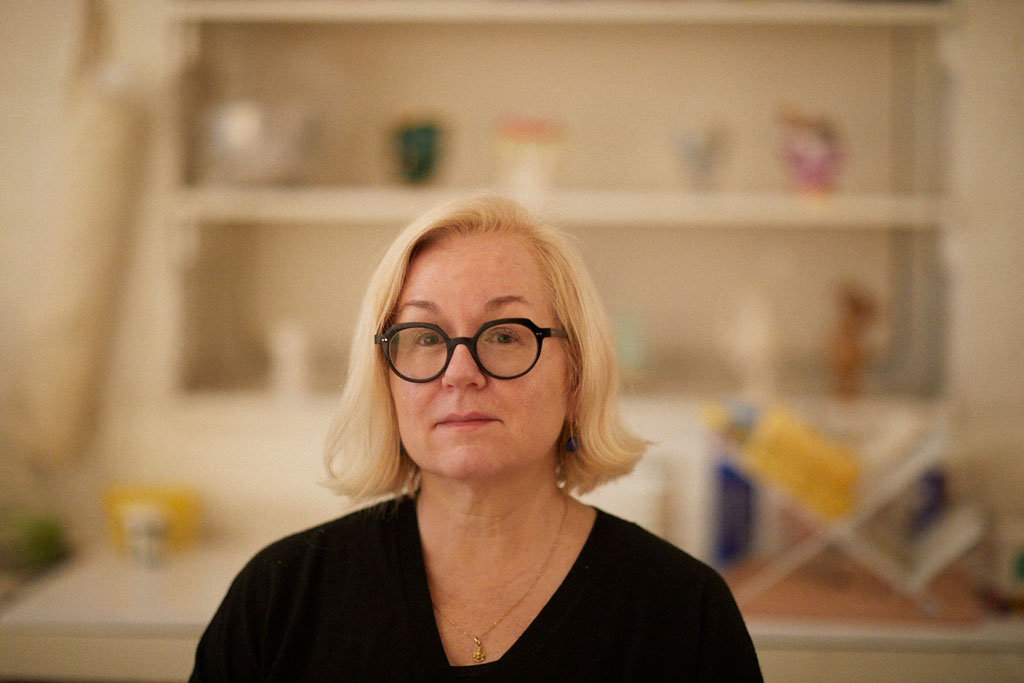
For an unabridged version of this interview, please visit the Artists’ Legacy Foundation.
Kathy Butterly (NA 2017) is an artist who lives and works in New York City and Searsmont, Maine. Butterly earned a BFA from Moore College of Art and an MFA from the University of California, Davis. In 2019, a mid-career survey consisting of 55 sculptures and works on paper were on view at the Manetti Shrem Museum of Art. She is preparing for an upcoming exhibition opening at the Contemporary Art Museum St. Louis in January, 2021. Butterly has been the recipient of many awards including a Guggenheim Fellowship, an Anonymous Was a Woman Award, a Joan Mitchell Foundation Grant, a Pollock-Krasner Foundation award, a Smithsonian Art Museum Contemporary Artist Award, and an Artist Legacy Foundation Artist Award, among others. Her work is represented in New York City by James Cohan Gallery and in Los Angeles by Shoshana Wayne Gallery.
Squeak Carnwath (NA 2019) draws upon the philosophical and mundane experiences of daily life in her paintings and prints, which can be identified by lush fields of color combined with text, patterns, and identifiable images. She has received numerous awards including the Society for the Encouragement of Contemporary Art (SECA) Award from San Francisco Museum of Modern Art, two Individual Artist Fellowships from the National Endowment for the Arts, a Guggenheim Fellowship, and the Award for Individual Artists from the Flintridge Foundation. Carnwath is Professor Emerita at the University of California, Berkeley. She lives and works in Oakland, California.
Michael Greenberg is a New York based portrait, entertainment, and advertising photographer. He takes his coffee with half & half and too much sugar.
